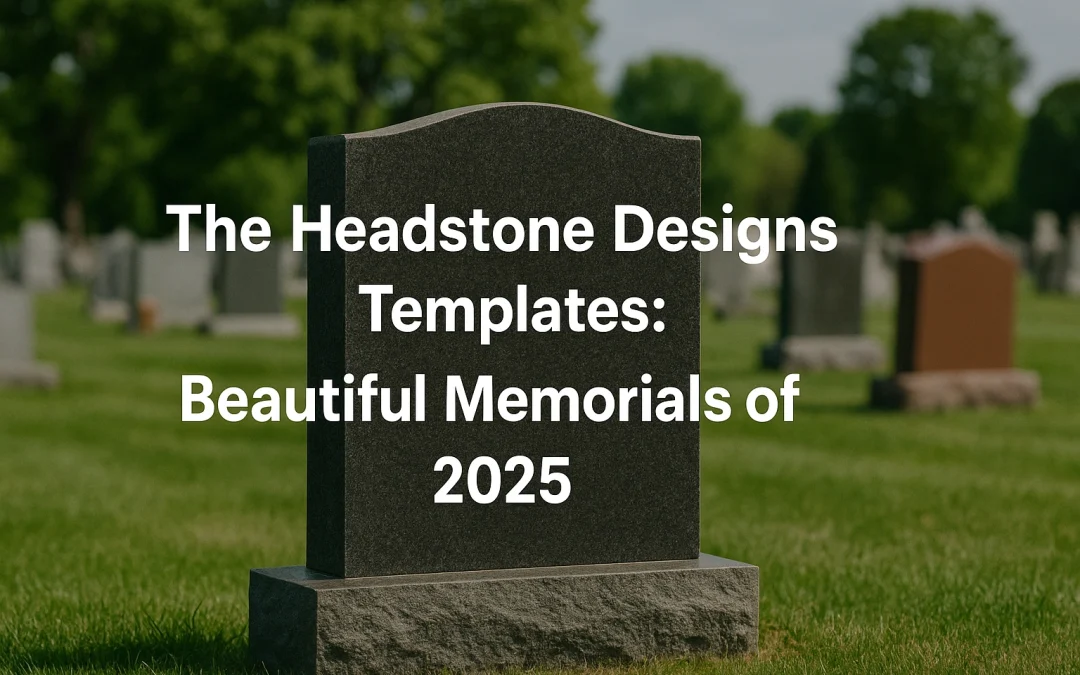Introduction to Headstone Designs Templates
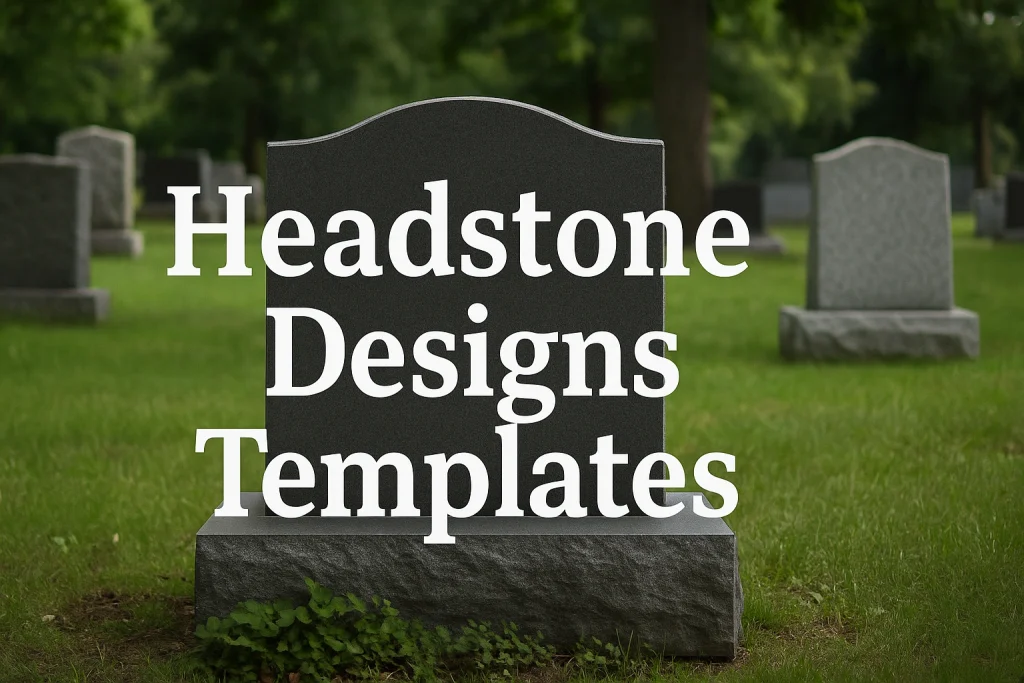
Selecting a headstone is one of the most heartfelt decisions families make after losing a loved one. It’s not simply about marking a resting place—it’s about creating a timeless tribute that tells a story, preserves memory, and provides comfort for generations to come. In this deeply personal process, headstone designs templates have become invaluable tools. They offer pre-structured design foundations that help individuals and monument makers transform emotion into art while ensuring every detail—from dimensions to inscriptions—meets cemetery regulations and aesthetic standards.
Modern headstone design templates provide more than just visual layouts. They combine artistry with technical precision, guiding users through aspects like headstone shape, size, material, and font selection. With downloadable and editable templates available online, even families unfamiliar with design can craft elegant, compliant memorials that reflect personality and meaning. These templates help maintain consistency for professional engravers while giving families creative freedom to personalize symbols, epitaphs, and imagery unique to their loved one’s life story.
Beyond aesthetics, templates simplify what can otherwise be an overwhelming process. They help avoid costly mistakes, reduce approval delays, and ensure the design aligns with cemetery requirements. Whether choosing a minimalist granite plaque, an intricately engraved upright monument, or a modern laser-etched design, templates provide clarity at every stage. This guide explores how to effectively select, customize, and apply headstone designs templates—covering everything from materials and personalization to compliance, costs, and long-term care—so you can create a memorial that is both beautiful and enduring.
2.What Are Headstone Design Templates & How They Help
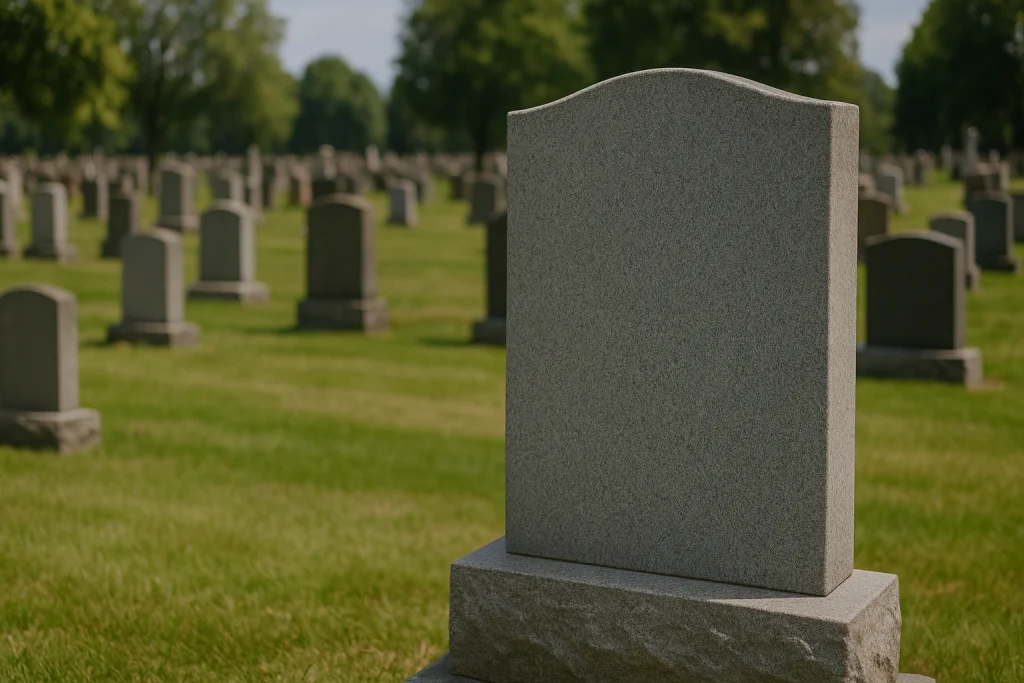
So what do we mean by headstone designs templates? In essence, a template is a pre-designed layout or starting file that defines the shape, size, inscription area and often the stylistic features fonts, symbols, border elements of a memorial stone. These templates come in various formats—printable PDFs, editable vector files (AI, SVG), or even online interactive tools. They are designed to streamline the process of designing a memorial: rather than starting from a blank slate, you choose a base layout and simply fill in names, dates, inscriptions and perhaps personalize icons or images.
Templates help in multiple ways: they save time, reduce errors especially when you consider cemetery size regulations, and offer a visual starting point that can aid decision-making. For example, if you download a upright headstone template 24×12″ guideline, you can sketch your inscription, visualize the layout and save on costly revisions later. Some providers offer free template downloads for families, others bundle premium templates within online design tools. For those managing multiple memorials—cemetery operators, monument companies—templates can become a workflow tool to standardize design and production.
3.Popular Headstone Shapes and Materials
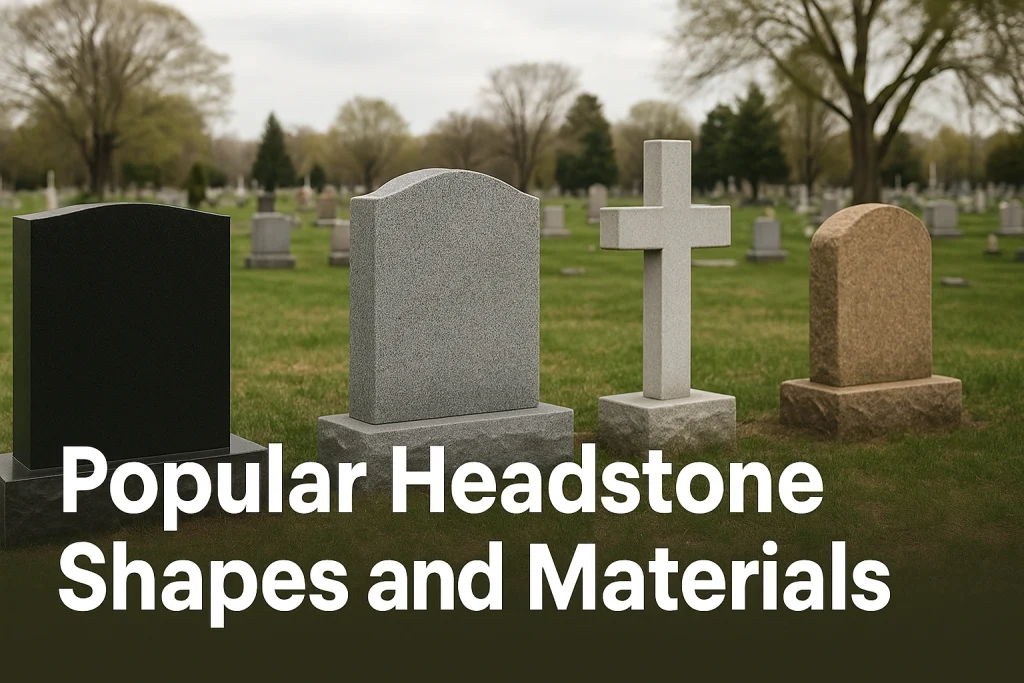
When selecting from headstone designs templates, the shape and material of the memorial are foundational choices—they influence both aesthetic and cost, and also determine which templates apply.
3.1 Upright, Slant, Flat – Choose the Right Shape
Upright headstones also known as vertical monuments stand tall, offering maximum space for inscriptions and personalization. They work well for family memorials or when you want a prominent tribute. In contrast, slant or bevel markers which rise at an angle and flat or lawn-level markers are more modest, lower in cost, and often preferred in cemeteries with uniform regulations. According to one guide, upright headstones provide more surface area and are better for more elaborate carving, while flat headstones are classic but offer less space for intricate design.
3.2 Material Options: Granite, Bronze, Marble
The choice of material matters: durability, finish, cost, and availability all vary. Granite is a top choice for headstones because it resists weathering and retains shine over time. Bronze is elegant but may patina with age; marble is more traditional but can suffer more in harsh climates. The template you choose should reference the material and shape you intend, to ensure correct proportions and finish.
3.3 Color, Finish and Durability Considerations
Granite comes in many colors—black, blue, gray, pink, red—and each has different visual impact. Black granite with laser-etching creates sharp, photo-quality imagery. For template usage, ensure the layout accommodates the finish: some shapes curved tops, wave edges cost more in shaping; simpler shapes cost less and may be more acceptable to cemeteries with stricter regulations. Cost, lead-time, and maintenance all depend on your shape and material decision.
4.Downloading and Using Headstone Templates
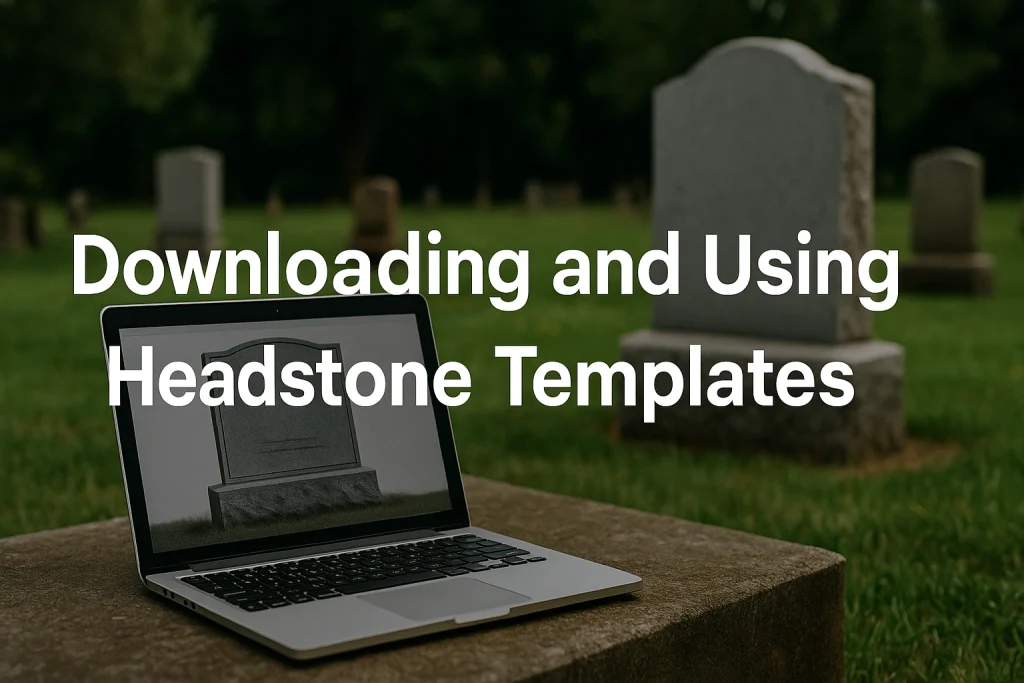
In this section we walk through how to choose, download and apply headstone designs templates effectively.
4.1 Free vs Premium Templates
Many sites offer free printable headstone templates—basic shapes and blank layouts ready to fill. For instance, one provider offers five free printable headstone design templates complete with vector files. While free templates are excellent starting points, premium templates often include editable layers for inscriptions and symbols, commercial-use rights, or design tool support—ideal for professional users or multiple memorials.
4.2 Printable & Editable Template Formats
When selecting a template, consider the format:
-
Printable PDF: simple, fill by hand or print for approval.
-
Vector AI, SVG, EPS: best for editing in design software, resizing without loss, customizing fonts and symbols.
-
Online interactive tool: drag-and-drop, select shapes, preview in 3D as some platforms provide. For example, one site allows you to choose shapes, upload images and preview in real time.
4.3 Step-by-Step: How to Use a Template Effectively
- Confirm cemetery regulations size limits, shape restrictions.
- Download a template that matches the permitted dimensions or one that can be resized.
- Open/edit the template: fill in names, dates, inscription text, position symbols/images.
- Preview the layout: ensure spacing, legibility and aesthetic balance.
- Submit for approval if required by cemetery or governing body and make revisions.
- Finalize the layout for production: save or export in required format PDF for fabricator, vector for CNC or laser etching.
- Store the template for future use or for companion memorials.
By following this workflow, you minimise errors, avoid costly re-work and move confidently from design to fabrication.
5.Personalizing Your Template: Inscription, Fonts & Symbols
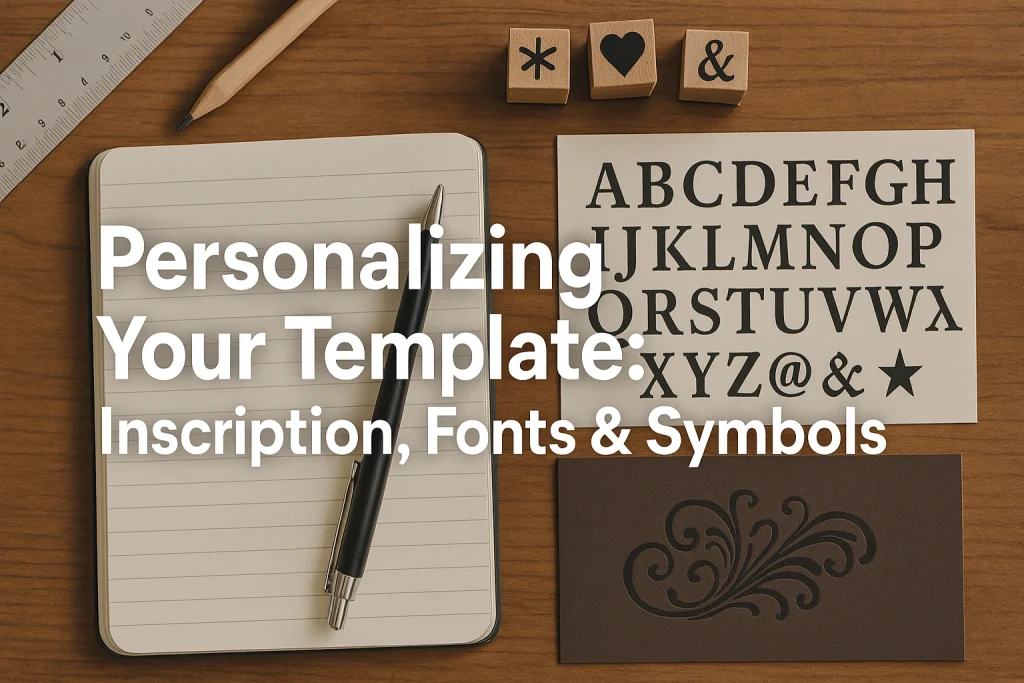
A headstone isn’t just a stone—it’s a story, a legacy. The personalized elements often carry the greatest emotional weight.
5.1 Choosing an Epitaph: Wording Guide
Most headstones include an identity line (name and perhaps relation), life dates, and a short epitaph or message. Some cemeteries even permit a symbol of belief or affiliation. As one guide recommends: keep each line brief and focused for maximum readability and impact. Example phrasing: Beloved Mother & Grandmother, Forever Loved, She Left The World Better. For personalization, consider including a short quote or reference meaningful to the deceased—but always confirm approval criteria with the cemetery.
5.2 Fonts and Lettering Styles for Headstones
Font choice influences longevity and legibility. Classic typefaces like Roman, Old English, Uncial, Gothic and Zapf Chancery are often used for monumental inscriptions. When using a template, ensure the text box allows for the expected font size and style. Avoid overly ornate fonts that compromise readability. In edit-capable templates, you may choose to preview how your own inscription reads in a selected font, and check spacing.
5.3 Symbol & Image Etching: Making It Unique
Symbols—crosses, angel wings, wildlife, sports emblems—allow personalization beyond text. One provider explains how symbols or photographs can meaningfully represent the person’s passions or beliefs. If including a photo, choose high-resolution (300 DPI+), minimal background, and check with the fabricator whether laser-etching or ceramic tile is best. A template that includes an image placeholder helps you visualise the space required, avoiding crowding text around the photo.
6.Design Styles & Layout Ideas
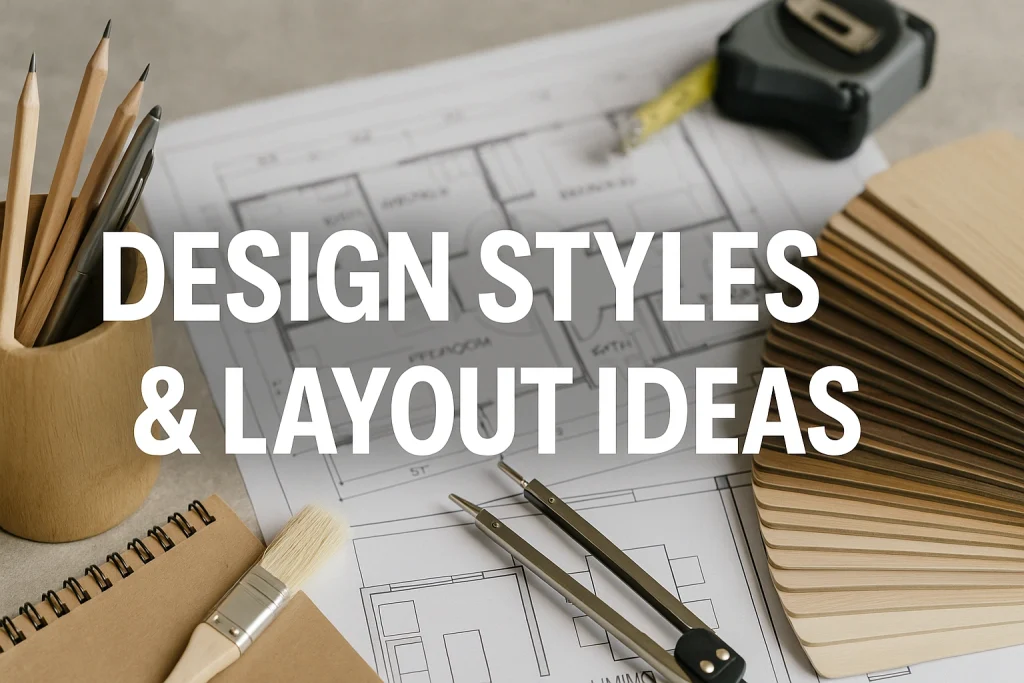
Templates aren’t one-size-fits-all. Your choice of style reflects the personality of the memorial and the loved one’s story.
6.1 Classic and Traditional Templates
Classic templates often feature upright rectangular shapes, arched or peaked tops, simple borders, serif fonts and minimal embellishment. These templates emphasise dignity, formality and longevity. Many families choose such templates for their timeless quality. One guide identifies classic shapes like upright headstones for elaborate carving, and flat markers for simple memorials.
6.2 Modern & Minimalist Templates
Modern templates may emphasise clean lines, minimal ornamentation, sans-serif fonts, photo-etch backgrounds, or integrated symbols. For those wanting a contemporary tribute, these layouts can feel fresh and relevant while still respectful. Some online designers allow selecting shapes like heart, wave, or teardrop to reflect unique style.
6.3 Themed or Symbolic Templates (Angels, Hearts, Trees)
Sometimes the design goes beyond shape and into theme: butterfly headstones, guitar shapes, sea-horse motifs, heart-top memorials—for example. These templates can serve families seeking strong symbolic resonance. When using such designs, verify that the cemetery allows non-standard shapes and that template outlines reflect the eventual shape accurately for cost and production.
7.Compliance: Cemetery Rules, Sizes and Installation
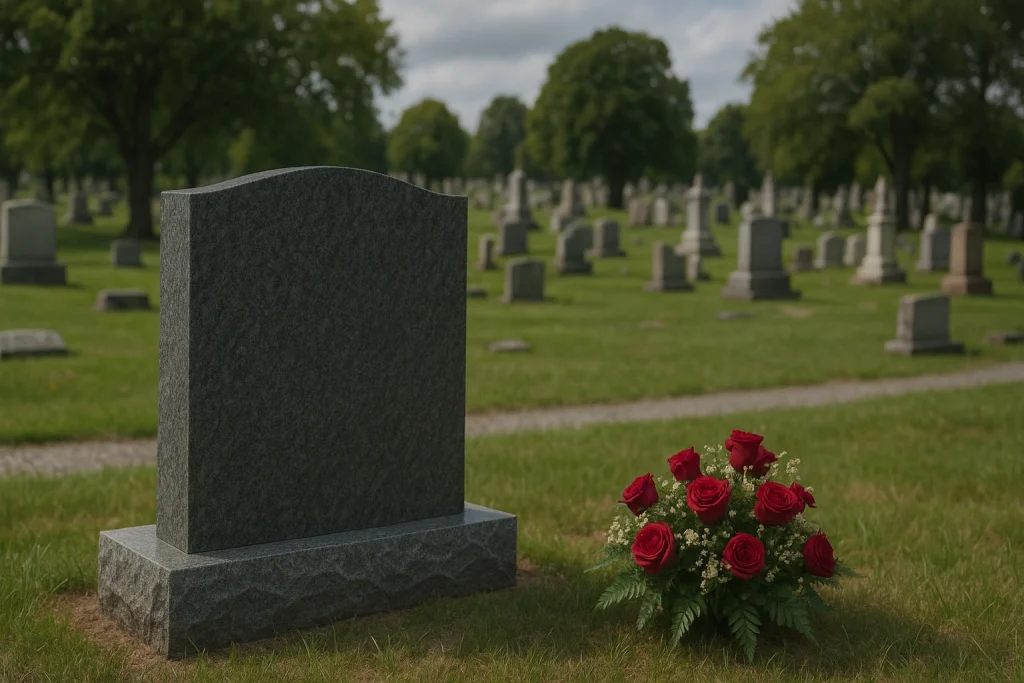
Even the best template can fail if it doesn’t comply with the cemetery’s regulations. This section emphasises the process of adapting templates to real-world rules.
7.1 Checking Cemetery Regulations Before Designing
Every cemetery (municipal, religious, veteran, private) has its own rules regarding headstone size, material, shape, base type and installer credentials. One guide underscores asking three essential questions: maximum height, permitted base width/depth, and restricted materials. Before finalising a template, obtain a rule sheet from the cemetery and ensure your chosen layout aligns.
7.2 Standard Sizes and Base Requirements
Common sizes: for single grass-level flat markers around 24″ x 12″ or 28″ x 16″; for companion upright stones maybe 36″ x 18″ or 44″ x 14″, as one provider allows. A template should either match or be easily resized to these dimensions so that once produced the stone will fit the foundation and lawn-level base specified by the cemetery.
7.3 Timelines, Permits and Approval Process
Approvals and lead-time matter. Many providers quote 8–16 weeks for standard jobs; custom shapes or non-stock color may take 16-22 weeks or more. Submitting a scaled drawing (generated from your template) often becomes part of the permit process. Ensuring your template can produce such a drawing saves time. For example: keep each line below ~66 characters to enhance readability and speed approval.
8.Cost Considerations: How Templates Affect Price
A template is more than a design—it influences budget. This section explores how different choices impact cost.
8.1 How Size, Material and Shape Impact Cost
Larger surface area = more stone, more transport, more base/installation cost. Premium materials (black granite, intricate shapes) cost more than standard configurations. One provider lists single upright granite at around US $1,000–$3,000, and companion upright $2,000–$5,000 (depending on extras).
8.2 Template Complexity vs Cost
Complex templates (curved wave tops, custom shapes, heavy image etching) typically increase fabrication time and cost—especially if special contour cutting is required. A simpler rectangular template is more cost-efficient and may be accepted by many cemeteries. When choosing a template download, consider whether it can be simplified without losing emotional impact.
8.3 Example Cost Table
| Template Type | Approx Size | Relative Cost |
|---|---|---|
| Flat granite marker | 24″ ×12″ | Low (entry) |
| Standard upright, rectangular | 30″ ×24″ | Medium |
| Customized shape with photo etching | 36″ ×30″ plus image | High |
| Companion/family headstone with full artwork | 48″ ×30″ plus symbols | Premium |
While template downloads often don’t include cost, using one helps you plan and compare quotes from monument fabricators.
9.Maintenance and Longevity of Headstone Designs
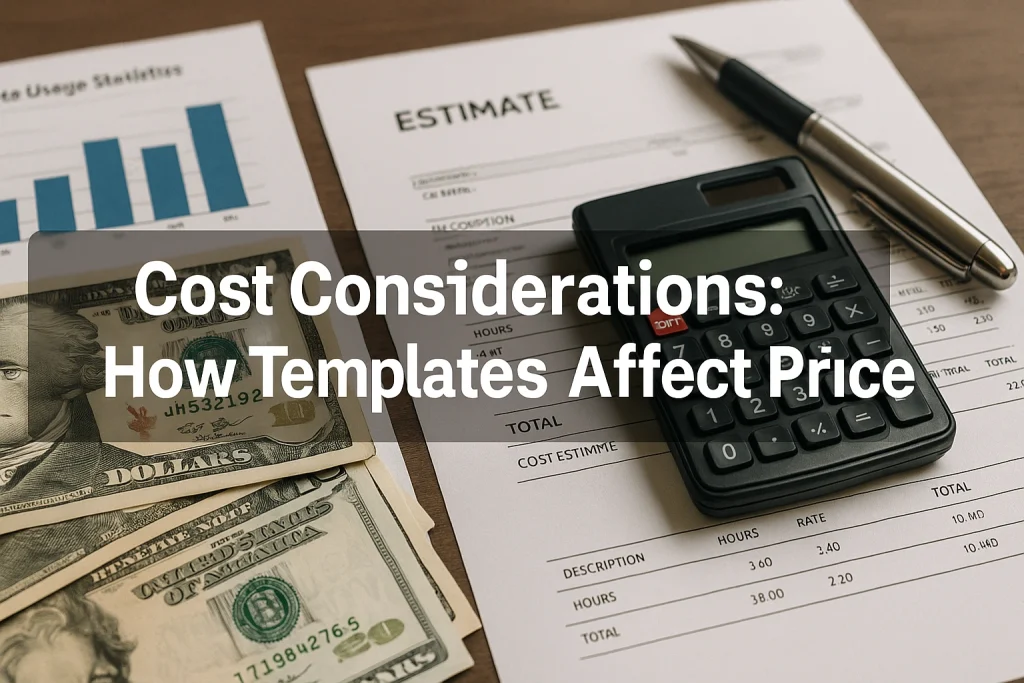
Choosing the right template now ensures your memorial remains legible and durable for decades or centuries.
9.1 Cleaning, Repairing, and Re-inking Letters
Maintenance is part of the design lifecycle. For example, our sources recommend cleaning with water, soft brush and non-ionic detergent; avoid bleach and power washers. If your template includes inset text or shallow engraving, plan for re-inking or repainting letters over time—something a production-ready template should allow for.
9.2 Longevity of Materials and Finishes
Templates that assume durable material (black granite + deep V-cut letters or laser etching) outperform softer stone or shallow engravings. One resource cites laser-etched black granite etchings having life expectancies of up to 200 years. If you choose a template with photo etching, ensure the production method is suited to withstand weather, sunlight, freeze/thaw cycles, and cleaning.
10.How to Select the Right Template for You
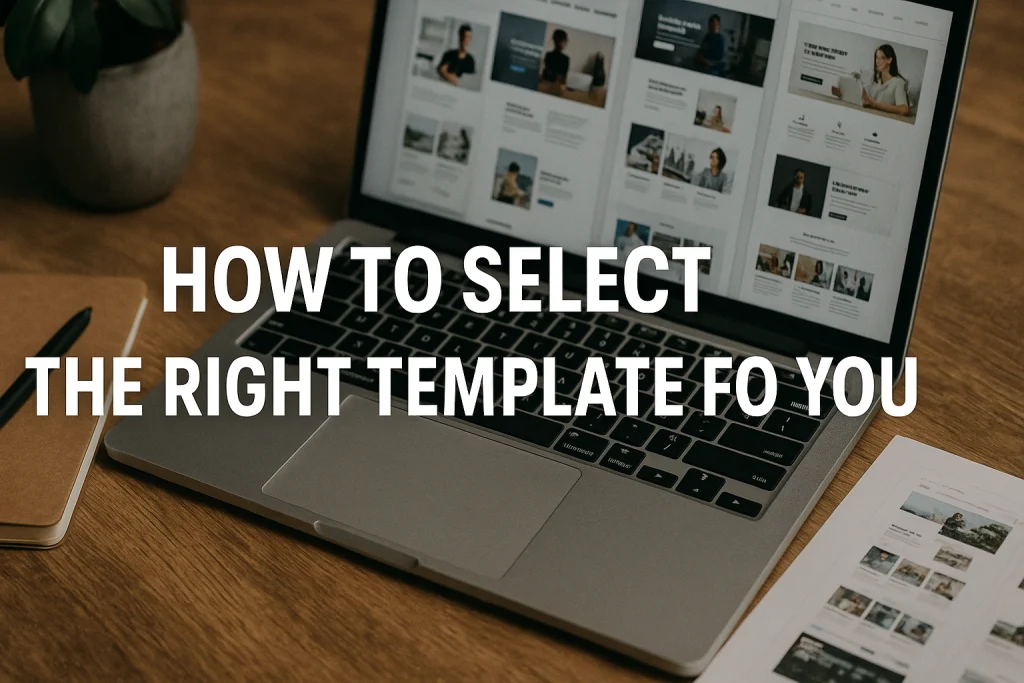
Bringing it all together, this section offers a practical checklist and decision-framework.
10.1 Checklist for Families
-
Confirm cemetery shape, size, material restrictions.
-
Choose the shape you feel best reflects the person (upright vs flat vs slant).
-
Download templates and test visualize with the engraving you want (name, dates, inscription, photo).
-
Personalize: pick fonts, symbols, images that reflect the loved one’s character.
-
Decide material and colour: ensure template supports the size/material.
-
Submit the layout for approval (scaled drawing) using the template.
-
Review cost quotes using your template as spec.
-
Ask about lead time, installation and maintenance.
10.2 Questions to Ask Your Monument Provider
-
Will the template be sized exactly for the foundation?
-
Is the inscription depth and font approved by the cemetery?
-
If I include an image, can the template handle the required resolution and etching method?
-
How soon will fabrication start once template is approved?
-
What maintenance does the production method require over time?
-
Can you provide a mock-up (digital proof) based on my selected template?
10.3 Mistakes to Avoid
-
Choosing a template without verifying cemetery rules (shape or material may be disallowed).
-
Downloading a printable template only (PDF) when an editable vector was needed for production.
-
Over-crowding the stone: too many words or images reduce readability and impact.
-
Underestimating timeline: custom shapes often take more than standard.
-
Neglecting maintenance: using shallow etching or soft stone leads to rapid wear.
11.Resources & Download Links

Here are some resources to explore for templates and tools:
-
Free printable headstone design templates (vector files) from AVP America.
-
Online headstone designer tools allowing editing in real-time.
-
Guides on choosing headstone size, materials and wording. headstonehub.com+1
-
Template libraries geared for monument fabricators (e.g., software with headstone template libraries).
Feel free to download a few sample templates, test with your inscription text and visualize how they look. Then, when you talk to your monument supplier, you’ll have a clear starting point.
12.Conclusion to Headstone Designs Templates
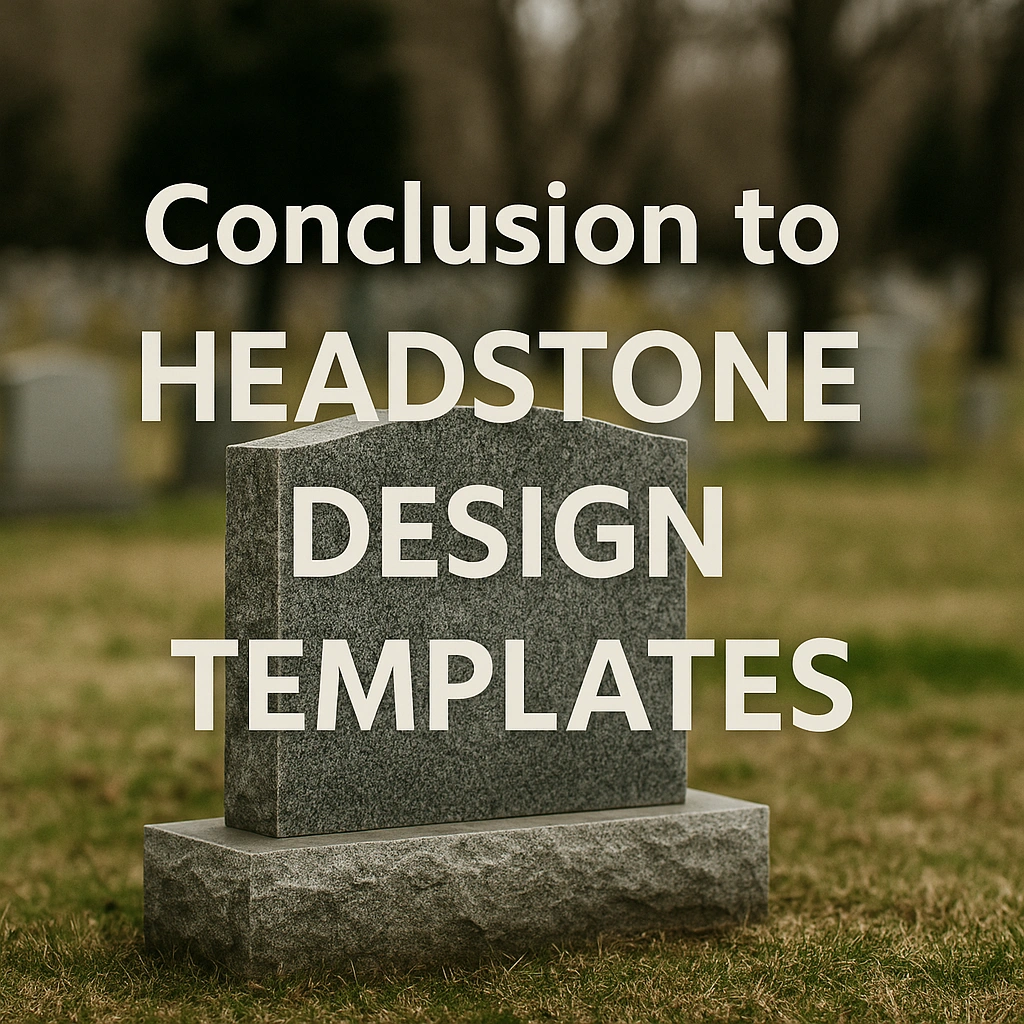
Creating a headstone is one of the final and most profound ways to celebrate a life lived. It represents love, memory, and legacy—all etched into stone for generations to see. Through the use of headstone designs templates, families and designers gain the ability to blend heartfelt storytelling with structural precision. These templates simplify the process of planning dimensions, inscriptions, and layouts while ensuring compliance with cemetery regulations. More importantly, they empower you to transform grief into artistry—turning ideas, emotions, and memories into a lasting tribute that truly reflects the individuality of the person it honors.
By using well-crafted design templates, you also save time, reduce design errors, and make collaboration with monument makers more efficient. They help you visualize options before production, compare materials like granite, bronze, or marble, and refine details such as epitaph wording or photo placement. This thoughtful preparation not only streamlines approvals but also guarantees a result that stands the test of time, both physically and emotionally.
As you finalize your design, remember that the goal is more than beauty—it’s connection. A thoughtfully designed headstone provides a sacred space for remembrance, healing, and reflection. Whether you choose a traditional upright monument or a modern laser-etched plaque, let your template serve as a guide toward balance between personal expression and timeless craftsmanship.
In essence, headstone designs templates are more than digital tools—they are pathways to creating memorials that combine artistry, meaning, and endurance. With care, planning, and creativity, your finished design will not only mark a resting place but also celebrate a life story that continues to inspire those left behind.

